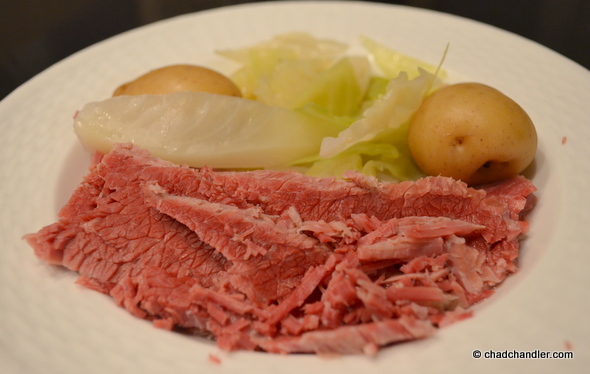
As I’ve mentioned before, I have a fridge in my new basement that I’ve dedicated to curing and aging meats. As part of that hobby, I thought I’d make some corned beef. I prepared it according to the instructions at AmazingRibs.com, which is a great resource for learning the hows and whys of properly cooked meats. They have especially good tips about barbecuing and meat preparation in general, although I must admit that I prefer my own processes for southern-style pulled pork and ribs.
Homemade Corned Beef
- 1 whole beef brisket
- 1 gallon water
- 1 cup brown sugar
- 1 cup kosher salt (Morton brand)
- 4 teaspoons pink curing salt #1
- 5 tablespoons pickling spices
- 4 cloves garlic, peeled and smashed
It can be hard to find a whole brisket. My usual grocery store only carries a prepackaged flat cut of brisket for around $35 (which is not a bad deal considering that it’s trimmed neatly). I was able to find a 14+ pound packer’s brisket (with both the flat and the point cuts) at Walmart for around $37. That’s an amazing bargain.
To begin, you separate the brisket into three pieces by cutting the point from the flat and then cutting the flat into halves. This diagram shows you what I’m talking about.
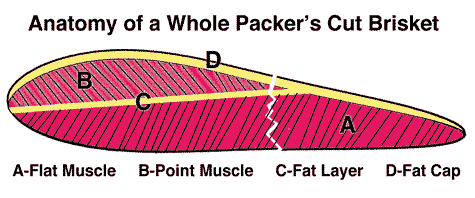
Here’s my brisket. It was a bit of a beast (pun intended).
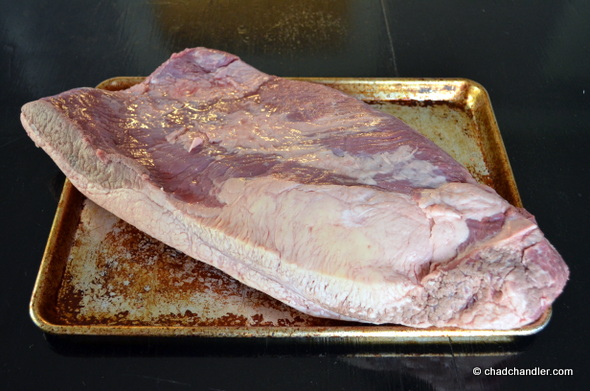
Breaking down the brisket takes a while. You need a very sharp knife. It took me half an hour to break mine down.
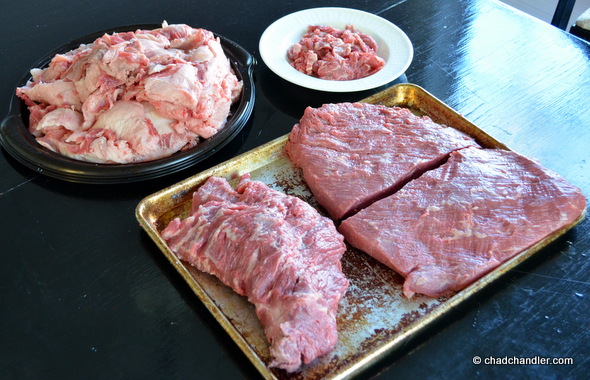
To explain what you’re looking at in this picture, there’s a large pizza-sized tray in the background piled a few inches high with fat. The bowl on the right is filled with meat that I over-trimmed. This might sound odd, but I keep a bag of beef bits in the freezer. When it gets pretty full, I grind it. This brisket, combined with a little lean sirloin, made some great hamburgers last week.
I trimmed the flat muscle (on the right) of all fat to be cooked as corned beef and left a little fat on the point muscle (on the left) to be cooked as pastrami since it will render on the smoker later.
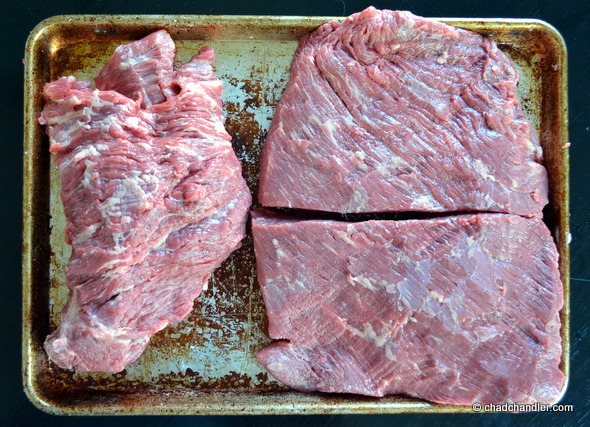
Next, you prepare the curing liquid. You can do this in any non-reactive container. I have a 5-gallon food grade bucket that I picked up at Lowe’s for $3. It’s good to have around for brining big foods like pork shoulders, whole turkeys, and chickens. Mix all of the brining ingredients together and break up any lumps.
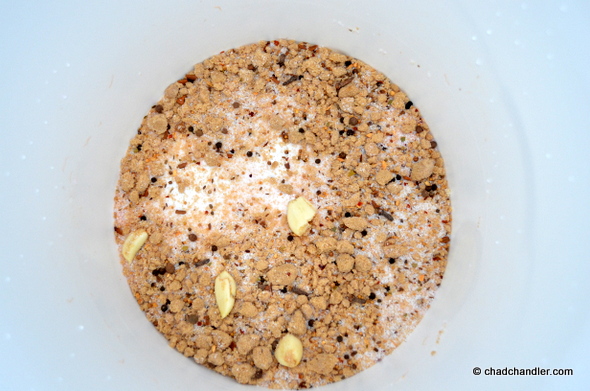
Add a quart of very hot water so the salt and sugar start to dissolve. Stir well. Finally, pour three quarts of cold water into the bucket to cool everything down. Add the meat and submerge. It might be necessary to weigh down the meat with a plate or something.
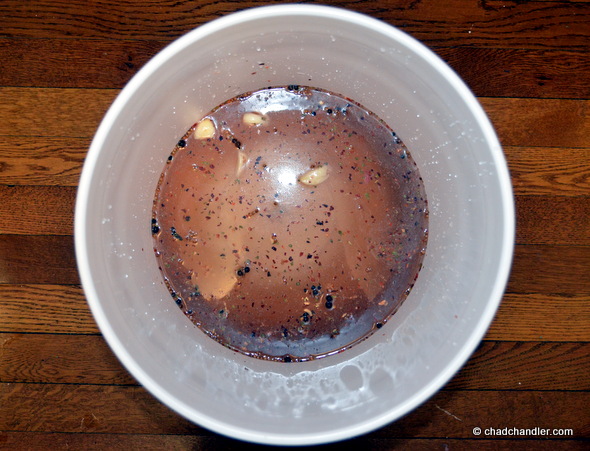
Place the bucket in a refrigerator for at least five days. It can go a lot longer. My beef cured for nine days because I was out of town for my sister’s wedding.
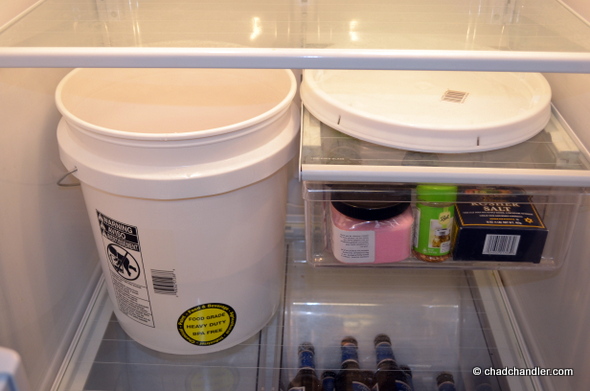
When the meat has cured, remove the pieces from the brine and give them each a quick rinse with cool water. My brisket looks a little gray here, but the traditional pink hue came out during the cooking process.
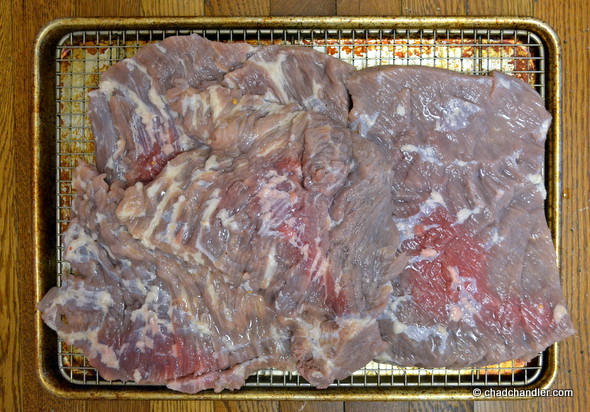
I set half of the flat aside for corned beef, dropped the cap meat back into the bucket filled with fresh water to desalinate for pastrami, and froze the other half of the flat for later use.
At this point, the corned beef is cured, but it’s still not cooked. To cook it, you submerge it in cold water by about and inch and slowly bring the pot to a slow simmer. After around 30 minutes on the stove, the beef should be heated through. Pour out all of the salty cooking water and cover again with warm water. Simmer on low for around three hours. You know it’s done when you can start to break up the strands of meat by pressing on them with a wooden spoon. Finally, remove the corned beef from the pot.
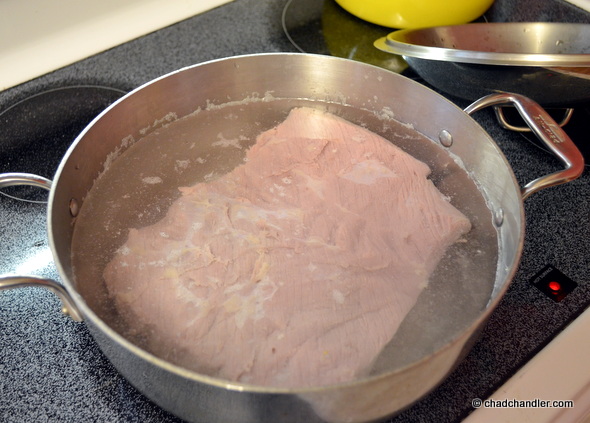
Corned beef can be served any way you like. I cut mine in half. I tossed half back into the pot for corned beef and cabbage and refrigerated the other half to be sliced cold for sandwiches later in the week.
As far as corned beef sandwiches, there’s nothing better than thinly sliced meat served with mustard. I’m not the biggest fan of rye, so I just used the bread I had on hand. I like my sandwiches served at room temperature, but you could steam the meat and serve it hot. You could also make a reuben. I like mine with mustard, but I’m a pretty simple guy.
This was a fun experiment and something that I’ll definitely make again. This corned beef was the best I’ve ever tasted by far. There’s a sweet taste from the brisket fat and the texture is nothing like the mushy, deli-sliced meat that you’re probably used to. It pulls into tender strands almost like barbecue. You really should try it.
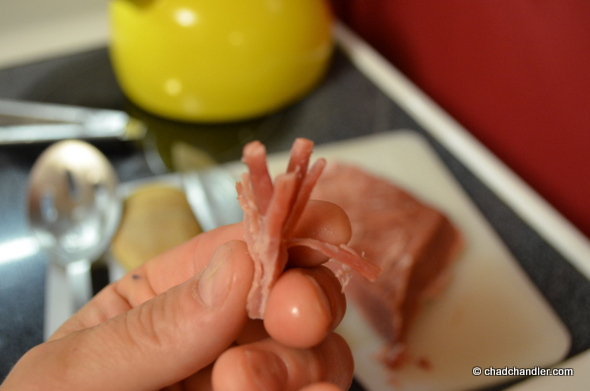
Now see how the pastrami turned out.







Pingback: Homemade Corned Beef & Cabbage | Chad Chandler
I found your article/recipe for ‘home-made’ corned beef interesting. I remember my mother making it once, only her recipe called for ‘salt peter’ to be added to the brine. Lots of comments made re the ‘salt peter’ since we lived on a military installation in Korea at the time. But it sure was good corned beef!
Pingback: Homemade Canadian Bacon | Chad Chandler